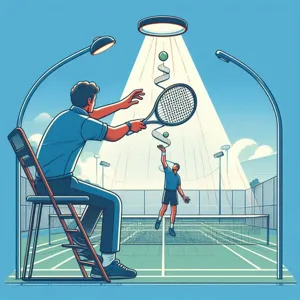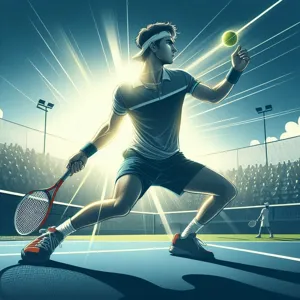Tennis is a sport that combines skill, strategy, and precision, and mastering the overhead shot can be the key to elevating your game to new heights.
Whether you’re a weekend warrior or a competitive player, perfecting your overhead can turn the tide in crucial matches, allowing you to dominate the court with confidence and finesse. In this blog post, we’ll delve into the top techniques that will help you ace your game and transform your overhead into a powerful weapon. From the fundamentals of footwork and positioning to advanced tips on timing and follow-through, we’ll explore the essential elements that contribute to an effective overhead shot. Get ready to elevate your performance and impress your opponents as you learn how to execute this pivotal stroke with grace and precision!
1. Understanding the Overhead Shot: What Makes It Unique

The overhead shot is often considered one of the most powerful weapons in a tennis player’s arsenal, yet it remains one of the most misunderstood techniques. Unlike groundstrokes that involve a rallying rhythm, the overhead is executed in a more dynamic and explosive manner, requiring a unique blend of timing, positioning, and technique.
What sets the overhead apart is its context: typically, it comes into play when your opponent has sent a high, arcing ball your way, often after a well-placed lob. This gives you an opportunity to capitalize on the situation and seize control of the point. The key to mastering the overhead lies in understanding its mechanics. Unlike a standard shot, the overhead requires you to strike the ball above your head, which can lead to a powerful angle and velocity when executed properly.
Additionally, the overhead shot is not just about brute strength; finesse plays a significant role. The ability to read the ball’s trajectory and judge the right moment to unleash your shot is crucial. Focus on your footwork to ensure you’re in the optimal position to generate power while maintaining balance. The racket face angle must also be precise, as this will influence the ball’s direction and spin.
Understanding the overhead shot is about more than just technique; it’s about strategy. When you can confidently execute this shot, you not only enhance your own game but also put your opponents on the defensive. A well-placed overhead can turn the tide of a match, creating opportunities for winners and forcing your opponent to scramble. As you delve deeper into mastering your overhead, remember that practice and repetition are essential to developing the muscle memory needed to make this shot second nature. Embrace the challenge, and soon enough, you’ll find that the overhead is not just a shot, but a statement of your growing prowess on the court.
2. The Importance of the Overhead in Tennis Strategy
The overhead shot is often described as the “putaway” shot in tennis, and for good reason. Mastering this technique not only adds a powerful weapon to your arsenal but also significantly influences your overall match strategy. When executed correctly, an overhead can be a game-changer, transforming a defensive situation into an offensive opportunity.
Understanding the importance of the overhead shot begins with recognizing its role in dictating the pace and flow of the game. When your opponent hits a high ball, either from a deep baseline position or during a lob, the overhead allows you to seize control of the point. It gives you the chance to attack rather than react, putting your opponent on the back foot. The psychological impact cannot be understated; a well-placed overhead can demoralize your adversary, making them second-guess their own shots.
In doubles play, the overhead becomes even more critical. It serves as a strategic tool to eliminate the net players from the equation, allowing you to create openings on the court. By mastering your overhead, you can effectively target the space behind your opponents, forcing them to scramble and making it more difficult for them to mount a defense.
Moreover, the overhead is not just about power; it’s about placement. A well-angled shot can keep your opponents guessing, while a deep overhead can push them back, creating opportunities for you to follow up with a volley or another strong shot. As you work on perfecting your overhead, remember to incorporate it into your overall game plan, using it to enhance your strategy and dictate the pace of play. When you recognize the importance of the overhead in tennis strategy, you’ll not only improve your performance but also elevate your game to new heights.
3. Proper Grip: Choosing the Right Technique for Overheads

When it comes to executing a perfect overhead in tennis, the foundation of your technique lies in your grip. The right grip not only enhances your control and power but also allows for greater consistency as you make contact with the ball. There are a few key grips to consider, each with its own advantages depending on your playing style and comfort level.
The **continental grip** is a popular choice among many players for overheads. To achieve this grip, place the base knuckle of your index finger on the second bevel of the racket handle, effectively allowing you to strike the ball cleanly while maintaining versatility in your shot selection. This grip enables you to generate both power and spin, making it easier to adapt your overheads to different situations on the court.
Alternatively, some players prefer the **Eastern grip**, which offers a bit more leverage and can help generate extra topspin. With this grip, your index knuckle rests on the third bevel of the racket handle. This position can provide a more natural feel when attempting to lift the ball over your opponents and can help you maintain a confident swing.
Regardless of which grip you choose, it’s essential to practice it consistently. Grip adjustments can vastly change the trajectory and pace of your overhead shots. Spend time in practice sessions focusing on your grip, ensuring that you feel comfortable and confident as you prepare for overheads. Remember, the key to mastering your overheads lies not just in the strength of your swing but in the finesse of your grip. As you refine this technique, you’ll find yourself executing overheads that are not only effective but also a pleasure to watch.
4. Stance and Positioning: Setting Up for Success
In the world of tennis, the stance and positioning you adopt can be the deciding factor between a powerful overhead shot and a missed opportunity. To set yourself up for success, it’s essential to establish a solid foundation before the ball even reaches you. Begin by positioning your feet shoulder-width apart, ensuring a balanced stance that allows for quick lateral movements. Your knees should be slightly bent, ready to spring into action, while your weight is distributed evenly across both feet.
As the opponent strikes the ball, shift your weight to your back foot, which helps generate the necessary power for your overhead. Keep your eyes on the ball and anticipate its trajectory, positioning yourself in the optimal spot to make the shot. Ideally, you want to align yourself with the ball so that it reaches its highest point directly above your head, offering you the best angle for a clean strike.
Remember, the key to effective positioning is staying light on your feet. As you anticipate the ball’s coming trajectory, practice quick footwork to ensure you’re not caught flat-footed. A slight pivot can help you turn your body towards the net, facilitating a more natural swing motion. By mastering your stance and positioning, you will not only enhance your overhead shots but also boost your overall confidence on the court, allowing you to play your best game with each swing.
5. Footwork Fundamentals: Moving Efficiently to the Ball

In the world of tennis, executing a perfect overhead shot doesn’t solely rely on the strength of your swing or the precision of your aim; it begins long before the ball reaches your racket. The foundation of a powerful overhead lies in your footwork. Proper footwork fundamentals are crucial for positioning yourself efficiently to the ball, allowing you to strike with confidence and accuracy.
To move effectively toward the ball, start by developing a strong athletic stance. Keep your feet shoulder-width apart, knees slightly bent, and weight balanced on the balls of your feet. This position will allow you to respond quickly to an opponent’s shot. As the ball is hit, use small, quick steps to adjust your position rather than large strides, which can lead to a loss of balance and timing.
As you anticipate the ball’s trajectory, focus on the direction it’s coming from. This will help you gauge not only where to move but also how quickly you need to react. A good practice is to incorporate lateral movements and backward sprints into your training routine, as these mimics the unpredictable nature of a match.
Once you’re in position, remember the importance of your body’s alignment. Turn your shoulders and hips towards the net as you prepare to strike, allowing your momentum to carry through the shot. This will not only enhance your power but also improve your accuracy by ensuring your body is aligned with your target.
Incorporating footwork drills into your practice sessions can significantly enhance your overall game. Consider exercises like cone drills, ladder drills, or shadow swings to sharpen your agility and responsiveness. The more fluid your footwork becomes, the more you’ll find yourself effortlessly gliding into position for that game-winning overhead smash. By mastering these footwork fundamentals, you set the stage for executing overheads that not only impress but also secure victory on the court.
6. The Swing Mechanics: Breaking Down the Overhead Stroke
### 6. The Swing Mechanics: Breaking Down the Overhead Stroke
To truly master the overhead stroke in tennis, it’s essential to understand the intricate mechanics that govern this powerful shot. The overhead is not just a simple act of swinging your racket; it is a symphony of movement, timing, and precision that, when executed correctly, can leave your opponents scrambling.
Begin by positioning yourself correctly. As the ball approaches, ensure you are facing the net with your feet shoulder-width apart, allowing for a stable base. Your knees should be slightly bent, which provides the necessary mobility to spring into action. The key to setting up for a successful overhead lies in your grip; a continental grip is often recommended, as it allows for optimal racket control and spin potential.
As the ball rises, your non-dominant hand should extend upwards, helping to track the ball’s trajectory. This visual cue is crucial; it keeps your eyes locked on the ball, giving you a better chance to gauge its speed and height. As you prepare to strike, rotate your shoulders and pivot on your back foot, which will generate the kinetic energy needed for a powerful shot.
The swing itself is where the magic happens. Start with a smooth, upward motion, bringing your racket back behind you while keeping your eye on the ball. As the ball reaches its apex, shift your weight from your back foot to your front foot, and initiate the forward swing. Your racket should move in a fluid arc, making contact with the ball at the highest point of your reach. Focus on a full follow-through; your racket should finish high, ideally over your shoulder, to ensure maximum power and accuracy.
Lastly, remember that practice is key. Spend time drilling your overheads to build muscle memory. Incorporate shadow swings into your routine, visualizing the perfect mechanics without the pressure of an actual match. By breaking down the overhead stroke into its component parts and dedicating yourself to refining each element, you’ll elevate your game and leave your opponents in awe of your newfound prowess on the court.
7. Timing Your Shot: When to Execute the Overhead

Timing your shot is crucial when executing an overhead in tennis; it can make the difference between a spectacular winner and a frustrating miss. The overhead is often a high-pressure play, and the key to mastering it lies in your ability to read the ball and anticipate your opponent’s shot. As the ball approaches, you need to take note of its trajectory and speed, which will inform you when to prepare for your overhead.
Ideally, you want to execute the overhead when the ball is at its highest point, allowing you to strike it with maximum power and control. This means positioning yourself correctly on the court, moving swiftly to get into the optimal hitting zone. As the ball ascends, keep your eye on it, and don’t rush your preparation. A well-timed overhead requires a delicate balance of patience and urgency.
Practice the art of gauging the distance between you and the ball. If it’s too far away, you risk hitting a weak shot. If you’re too close, you might misjudge the angle and send it into the net. As you develop your skills, focus on your footwork; being light on your feet will help you adjust your position quickly and get into the right stance.
Additionally, remember to watch your opponent. Understanding their positioning and intent can give you an edge in predicting their next move, allowing you to time your overhead perfectly. Whether you’re facing a lob or a deep shot, the ultimate goal is to stay calm and collected. With practice and proper timing, your overhead can become a powerful weapon in your tennis arsenal, turning potential points into game-changers that keep your opponents on their toes.
8. Practicing with Purpose: Drills to Improve Your Overhead
Practicing with purpose is essential for mastering your overhead shot in tennis. Rather than simply hitting balls haphazardly, focus on structured drills that target specific aspects of your overhead technique. One effective drill involves partnering with a friend or coach who can feed you high balls from different angles. Start with basic feeds that allow you to get comfortable with your footwork and timing, then gradually increase the difficulty by introducing lateral movement or varying the height and spin of the ball.
Another excellent drill is the “overhead and volley” sequence. Begin by hitting an overhead, and immediately follow it up with a volley. This simulates real-match situations where you may need to capitalize on an opponent’s weak return. It also helps build muscle memory and sharpens your reflexes, as you’ll need to react quickly and adjust your positioning.
Incorporate shadow swings into your practice routine as well. Visualize hitting the ball while focusing on your form and mechanics without the distraction of an actual ball. This can help reinforce proper technique, ensuring that you’re consistently maintaining the right grip, stance, and follow-through when it’s time to step onto the court.
Finally, consider recording your practice sessions. Watching the footage can provide valuable insights into your form and help identify areas for improvement. By approaching your practice with intention and utilizing these targeted drills, you’ll not only enhance your overhead skills but also gain the confidence needed to execute them flawlessly during competitive play. With each purposeful practice session, you’ll find yourself one step closer to acing your game.
9. Common Mistakes and How to Avoid Them
Mastering overheads in tennis can significantly elevate your game, but even seasoned players can fall prey to common mistakes that hinder their performance. Understanding these pitfalls and knowing how to avoid them is crucial for achieving consistency and confidence in your shots.
**1. Poor Footwork**
One of the most frequent errors is inadequate footwork. Many players underestimate the importance of positioning themselves correctly under the ball. To avoid this, practice your footwork drills. Focus on getting into the right stance early, allowing you to strike the ball with balance and power. Remember, your feet should be light and agile, ready to adjust quickly as the ball approaches.
**2. Inconsistent Grip**
Another common mistake is using the wrong grip or changing grips mid-swing. This inconsistency can lead to mishit balls and erratic shots. To remedy this, decide on a grip that suits your style—typically, the continental grip is favored for overheads—and stick with it during practice. Consistency is key, and developing muscle memory will significantly improve your overheads.
**3. Neglecting the Follow-Through**
A common oversight is failing to complete the follow-through after hitting the ball. This can result in a loss of power and accuracy. Make it a point to practice a smooth, full follow-through, extending your racket towards the target. Not only does this enhance your shot, but it also sets you up for the next play, ensuring you’re ready for whatever comes next.
**4. Overlooking the Importance of Timing**
Timing can make or break an overhead shot. Rushing to hit the ball or waiting too long can lead to poor execution. Work on your timing by practicing with a partner or a ball machine. Focus on making contact at the peak of your jump or the highest point of the ball’s trajectory. This practice will help you develop a better sense of when to strike.
By identifying these common mistakes and actively working to correct them, you’ll find that your overheads become more reliable, powerful, and precise. Regular practice, combined with a focus on footwork, grip, follow-through, and timing, will not only enhance your technique but also boost your confidence on the court. So, the next time you step up for that critical overhead, you’ll be ready to ace your game!
10. Mental Preparation: Boosting Confidence for Overhead Shots
When it comes to executing perfect overheads in tennis, mental preparation is just as crucial as physical practice. The overhead shot can be one of the most intimidating plays, especially when executed under pressure, but building confidence in your mental game can significantly enhance your performance on the court.
Start by visualizing success. Before you step onto the court, take a moment to close your eyes and picture yourself executing flawless overheads. Imagine the ball soaring over the net, your body in perfect alignment, and the crowd erupting in applause. This positive mental imagery not only prepares your mind for the task at hand but also conditions your body to respond to the situation with confidence.
Additionally, practice mindfulness techniques such as deep breathing or meditation to calm any pre-match jitters. Focusing on your breath can center your thoughts and help you stay present during crucial points in the match, allowing you to execute your overhead shots with precision rather than anxiety.
Reinforcing a growth mindset is also vital. Understand that mistakes are a natural part of the learning process. Instead of dwelling on past failures, remind yourself of your progress and the dedication you’ve put into honing your skills. Embrace challenges as opportunities to improve, and approach each match with the belief that you can overcome obstacles.
Finally, consider setting small, achievable goals for your overhead shots during practice sessions. This could be as simple as aiming to successfully land a certain percentage of your overheads in specific areas of the court. Celebrating these small victories builds a sense of accomplishment that translates into greater confidence when it counts.
By focusing on mental preparation, you can transform your approach to overheads, turning what was once a source of anxiety into a powerful weapon in your tennis arsenal. With the right mindset, you’ll not only feel more confident in your abilities but also enhance your overall performance on the court.
11. Analyzing Professional Players: Learning from the Best
One of the most effective ways to elevate your overhead game is to analyze the techniques of professional players. The world’s top tennis athletes have honed their skills through years of dedication, practice, and experience, and their matches offer a goldmine of insights that can benefit players at any level. Watching these elite competitors in action allows you to observe the nuances of their overhead shots—their footwork, body positioning, and timing.
When studying professional players, focus on how they approach the overhead from different positions on the court. Notice how they prepare for the shot: do they keep their eye on the ball, and how do they track its trajectory? Pay attention to their grip, swing mechanics, and how they generate power without sacrificing control. For instance, players like Rafael Nadal and Serena Williams often exhibit a fluid, explosive motion that combines strength with precision.
Additionally, try to analyze their mental game. Professional players often display remarkable composure under pressure. Observe how they maintain focus and confidence, even in high-stakes situations. This mental fortitude can be just as crucial as physical skill when it comes to executing a perfect overhead.
To make the most of your analysis, consider using video analysis tools that allow you to slow down and dissect the movements of these pros. You can compare your technique side-by-side with theirs, identifying areas for improvement. Incorporating drills inspired by their styles into your training regimen can also help simulate a professional environment, pushing you to elevate your game.
In summary, learning from the best not only inspires your practice but also equips you with the knowledge and techniques necessary to refine your overhead shots. By adopting the methods of professional players, you’ll be well on your way to mastering this critical aspect of your game.
12. Incorporating the Overhead into Match Play
Incorporating the overhead into match play is more than just a technical adjustment; it’s a strategic evolution that can elevate your game. The overhead is often regarded as the “bread and butter” shot for players at all levels, serving as a powerful weapon to seize control of points and put pressure on your opponents. However, executing it effectively during a match requires not only skill but also tactical awareness.
First, it’s essential to recognize the situations where the overhead can be most effective. When your opponent lobs the ball over your head, this is your cue to position yourself for an aggressive overhead smash. Anticipate the ball’s trajectory and move quickly to get into position, ensuring you’re balanced and ready to strike. The key is to remain calm and focused, as over-committing can lead to mistakes.
Practicing your overhead in drills is beneficial, but translating that practice into match play is where the real challenge lies. During a match, it’s crucial to watch your opponent’s body language and shot selection. If they consistently hit deep shots toward the baseline, be prepared for the possibility of a lob, and stay alert for that opportunity to capitalize on your overhead.
Moreover, integrating the overhead into your overall game strategy can create a psychological edge. When opponents know you have a strong overhead, they may hesitate to attempt lobs, allowing you to dictate the pace of the game. Use this to your advantage by mixing up your shots. A well-placed overhead can not only win you the point but can also force your opponent into making hasty decisions, leading to errors in their play.
Finally, remember that confidence is key. Embrace the overhead as one of your go-to shots. With each successful execution in match play, your confidence will grow, making you a more formidable opponent. By practicing regularly and being mindful of game situations, you can seamlessly incorporate the overhead into your playing style, turning it into a reliable asset that keeps your opponents on their toes. Ace your game by mastering this crucial technique, and watch as your match play transforms.
13. Adapting Your Overhead for Different Court Surfaces
When it comes to perfecting your overhead in tennis, one of the most crucial yet often overlooked aspects is adapting your technique to suit different court surfaces. Each surface—be it clay, grass, or hard court—offers unique characteristics that can significantly impact the way your overhead is executed and received.
On **hard courts**, the surface provides a consistent bounce and allows for a powerful strike. Here, you can afford to be aggressive; the predictability of the ball’s trajectory means you can step into the shot with confidence. Focus on generating maximum racket speed and height, aiming to hit the ball with precision while it rises. This is the ideal surface for practicing explosive overheads, as you’ll have the space to follow through without worrying about the ball skidding or bouncing unpredictably.
In contrast, **clay courts** can present a different challenge. The softer surface tends to slow down the ball and offers a higher bounce, necessitating a more strategic approach. When playing on clay, it’s essential to anticipate the ball’s trajectory earlier and adjust your positioning accordingly. A more measured swing may be required here—emphasizing control over sheer power. Work on your footwork to get into the optimal position, and use a more compact swing to ensure that you can adapt to the varying speeds of the ball.
Finally, on **grass courts**, the experience is distinctly different yet equally exhilarating. The low, fast bounces require quick reflexes and sharp decision-making. Grass can be slippery, making it vital to maintain balance while executing your overheads. Here, you’ll want to focus on quick, wristy flicks rather than full swinging motions, as the unpredictable nature of the bounce can catch even the most seasoned players off guard. Practicing short, powerful overheads will help you capitalize on the fast-paced game that grass courts promote.
By honing your overhead technique for each surface, you’ll not only improve your overall game but also gain a competitive edge against your opponents. Remember, adaptability is key in tennis—embrace the nuances of each court to elevate your skills and keep your opponents guessing!
14. Using Technology: Apps and Tools to Track Your Progress
In the ever-evolving world of sports, technology has become an indispensable ally for players looking to sharpen their skills and track their progress. When it comes to perfecting your overheads in tennis, leveraging apps and tools can provide invaluable insights into your performance and help you identify areas for improvement.
There are a plethora of apps designed specifically for tennis enthusiasts. These apps can record your match statistics, analyze your shot accuracy, and even provide video analysis to help you visualize your technique. For instance, platforms like Tennis Tracker and SwingVision allow you to monitor your overhead shots, measuring factors such as speed, spin, and placement. By regularly inputting data from your practice sessions and matches, you can create a comprehensive overview of your strengths and weaknesses, enabling you to focus your training efforts effectively.
In addition to dedicated tennis apps, fitness trackers and smartwatches can also play a crucial role in your development. Many of these devices come equipped with heart rate monitors, GPS tracking, and motion sensors that can provide a wealth of information about your physical condition and movement patterns on the court. By analyzing this data, you can gain insights into your stamina, agility, and overall performance, allowing you to tailor your training regimen to better suit your needs.
Moreover, consider integrating video analysis tools into your practice routine. Recording your overhead shots from different angles can reveal nuances in your form that may be difficult to notice in real-time. Apps like Hudl Technique or Coach’s Eye allow you to slow down footage, annotate your movements, and compare your strokes against professional players. This visual feedback can be instrumental in refining your technique and boosting your confidence during matches.
Ultimately, using technology to track your progress not only keeps you informed but also motivates you to stay committed to your training. By setting specific goals within these apps and celebrating your milestones, you’ll maintain a forward momentum that can lead to significant improvements in your overhead game. Embrace the power of technology, and watch your skills soar to new heights!
15. Conclusion: Embracing the Journey to Master Your Overhead
As we reach the conclusion of our exploration into perfecting your overhead in tennis, it’s essential to remember that mastery is not an end goal but a journey. Each practice session, every match played, and all the challenges faced along the way contribute to your growth as a player. Embracing this journey means being open to learning from mistakes and celebrating small victories, whether it’s hitting a particularly crisp overhead or executing a well-timed volley.
Perfecting your overhead is about more than just technique; it’s a mental game as well. The pressure of high-stakes moments can often lead to hesitation or uncertainty. However, by consistently honing your skills and building confidence through repetition, you can transform those challenging situations into opportunities for triumph. Visualize your success, focus on your footwork, and trust in the hours of practice you’ve invested.
Remember, every great player has faced their own hurdles—what sets them apart is their resilience and commitment to improvement. So, step onto the court with enthusiasm and a positive mindset. Approach each practice with the intent to learn, adapt, and refine your technique. As you continue to embrace the journey of mastering your overhead, you’ll not only elevate your game but also deepen your love for this incredible sport. The path to excellence is paved with dedication, and each overhead you perfect is a testament to your commitment to the game. So grab your racquet, hit the court, and enjoy every step of this exhilarating journey!
As we wrap up our exploration of the top techniques to perfect your overheads in tennis, we hope you feel inspired and equipped to elevate your game on the court. Mastering the overhead is not just about power; it’s about precision, timing, and confidence. By incorporating the drills and tips we’ve discussed, you’ll develop a more reliable and effective overhead shot that can turn the tide of any match in your favor. Remember, practice makes perfect, so take these insights to your next training session and watch as your skills flourish. Here’s to acing your game and enjoying every moment on the court—your opponents won’t know what hit them!






